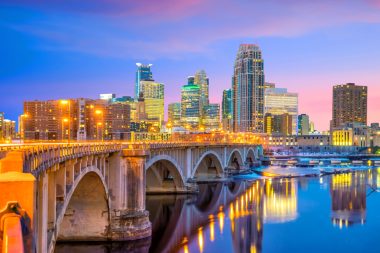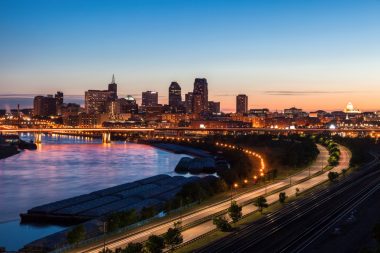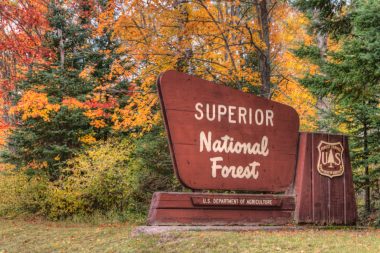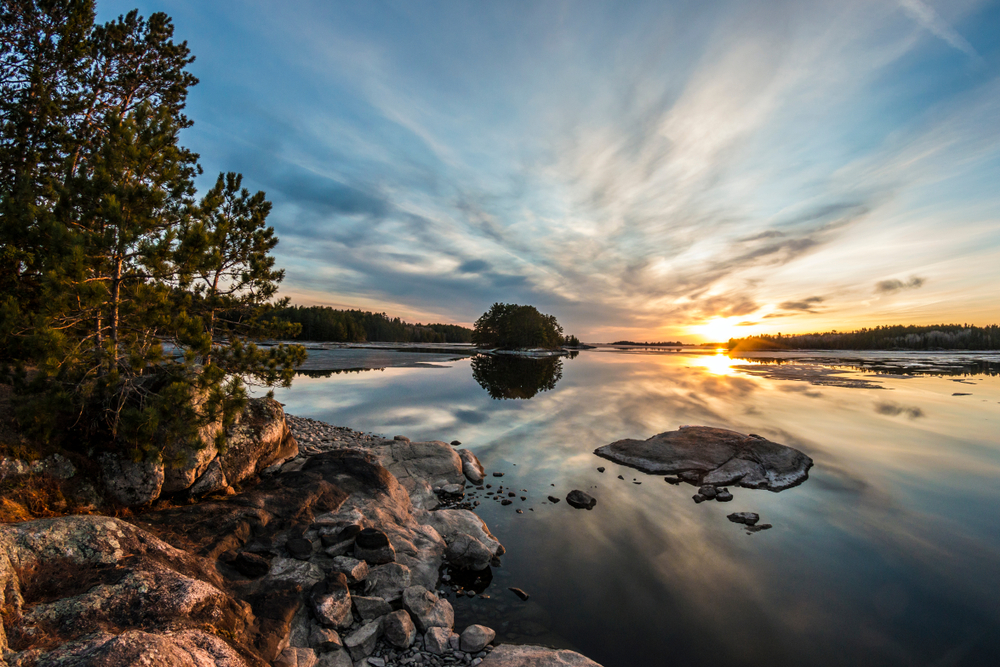Often untouched natural landscapes, the famous “10,000 Lakes”, extensive forest areas and the well-known “Twin Cities” – the state of Minnesota offers its visitors breathtaking natural spectacles, a varied cultural diversity and impressive sights to discover.
Minnesota is the northernmost state in the USA next to Alaska and borders directly on the large lakes that are so distinctive and unmistakable for this region and have a lasting impact on the area. The twin cities of Minneapolis and Saint Paul, known as the “Twin Cities”, form the impressive metropolitan area of the state, which is the political, economic and cultural center of Minnesota.
About two-thirds of the total population live in this social epicenter and the adjacent surrounding area. Countless paths, green spaces and parks crisscross this region and, in combination with a wide variety of excursion options, offer visitors an exciting and varied programme for nature lovers, culture enthusiasts and big city fans.
Rural Minnesota, with its tranquillity, seclusion and distinctive lake areas, forms a fascinating and impressive contrast to the modern, urban and bustling twin cities. The numerous water areas, atmospheric forests and countless hiking trails leave nothing to be desired, especially for nature lovers and active athletes.
Dubbed the “Land of 10,000 Lakes,” Minnesota is at its best here.
Twin Cities – Metropolitan Cities with Cultural Diversity

The two sister cities of Minneapolis and St. Paul (also called MSP after the airport code) together form a city complex on the upper reaches of the Mississippi River. The associated airport is an important hub for many travelers, but both cities alone offer a special and interesting program for your own, extended visit.
The city of Minneapolis presents an exciting mix of hip modernity and original tradition. The spectacular skyscrapers in the city are surrounded by interesting and diverse neighborhoods, so-called “hoods”. These house, for example, old warehouses, which are now renovated and used as urban localities in a variety of ways.
The “Mill District”, the “Downtown East” and the “Warehouse District” have been given new life and a refreshing revitalization through new shops, apartments and trendy shops. The “Central Business District” as the central square of the business and financial world as well as the very multicultural “Midtown” with “Eat Street” and the “Midtown Global Market” are further sights in the heart of the city.

Summit Avenue is home to many magnificent and stately mansions, churches, synagogues, and schools built and built in the Victorian style. The mix of historic buildings and modern buildings gives this area a unique architectural feature and is considered a national-American cultural asset.
The Twin Cities are famous for a great and nationally recognized cultural and music scene – the “Walker Art Center” with the Sculpture Garden, the “Institute of Art”, the Dakota Jazz Club, the “First Avenue”, the “Weisman Art Museum” and the Guthrie Theater are just a few examples of the excellent offer in this area.
The “Landscape Arboretum” is a nature experience of a special kind. Well-kept gardens of all kinds, various forests, rugged prairie land and many paths to ski and ice skate in winter form a fascinating kaleidoscope of natural uniqueness.
Less than 15 kilometers from Minneapolis, Saint Paul, a quiet, green and almost tranquil city, is a pleasant haven of peace in contrast to the bustling and more business-oriented Minneapolis. Visitors can commute back and forth between the two cities by tram, as well as to the famous “Mall of America” (MOA) in Bloomington.
This is one of the largest shopping malls in the United States – a limitless variety of shops, shops, bars, restaurants, movie theaters, and even an indoor theme and amusement park, as well as a golf course and aquarium, offers an incredible smorgasbord of opportunities for fun. Numerous concerts, performances and other events offer special entertainment and a variety of entertainment almost every day.
Just outside the city, in Harriet Island Regional Park, which forms part of the vast National River & Recreation Area, visitors get a magnificent view of the area and also two particularly unique buildings: the French Renaissance cathedral and the State Capitol.
Minnesota – pure nature and fantastic landscapes
Minnesota is a true mecca for outdoor enthusiasts and offers endless forests, deep blue lakes and often untouched nature. A visit to the “Voyageurs National Park”, located on the border with Canada , is absolutely worthwhile, especially in autumn, when the colourful foliage offers a particularly wild and romantic ambience full of splendour. Countless lakes and waterways cover almost half of the park, and visitors can see numerous pelicans and one of the largest gray wolf populations in the country.

Even away from the countless waters, visitors to Minnesota can be active in the idyllic forests at any time of the year. The Superior National Forest offers miles of trails for hiking, walking, or cross-country skiing in the winter. The “Itasca State Park” near the city of Bemidji is home to the headwaters of the Mississippi, and ancient pine forests provide a very special scenic flair.
The forests, parks and nature reserves offer impressive impressions for outdoor freaks and nature lovers, who can choose from a wide range of different activities such as canoeing or kayaking, boat tours, cycling, swimming (summer) or hiking, cross-country skiing or snowmobile rides (winter) in the wild.
Getting to Minnesota
Minnesota has a time difference of about seven hours to Germany , although the aforementioned international airport also has direct connections to German locations. The climate is sometimes extremely cold in winter due to the polar air current, but the summer months can also be warm and humid (regularly over 20 degrees Celsius).
The best times to travel are therefore spring and early autumn.
Können wir Ihnen helfen?
Benötigen Sie Unterstützung bei Ihrer Reiseplanung oder weitergehende Informationen zu einzelnen Reisezielen? Wir freuen uns über Ihre Kontaktaufnahme.


